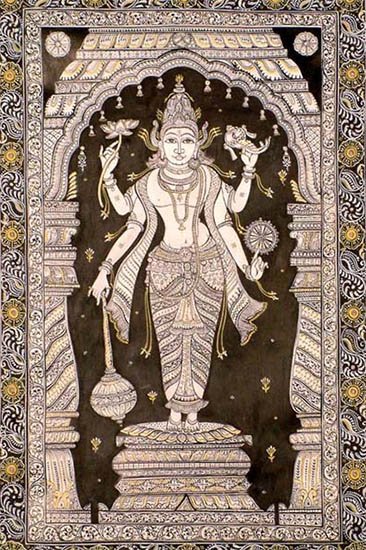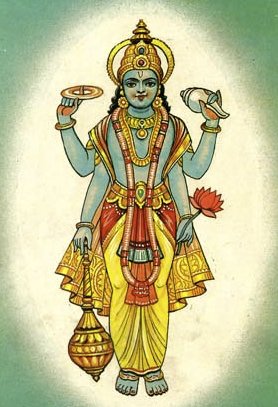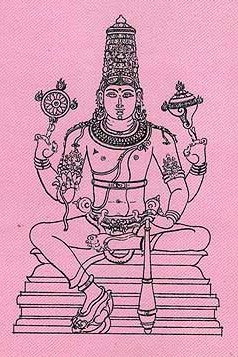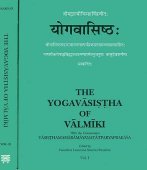Kriyashakti, Kṛyāśakti, Kriya-shakti, Kriyāśakti, Kriyasakte: 13 definitions
Introduction:
Kriyashakti means something in Hinduism, Sanskrit. If you want to know the exact meaning, history, etymology or English translation of this term then check out the descriptions on this page. Add your comment or reference to a book if you want to contribute to this summary article.
The Sanskrit terms Kṛyāśakti and Kriyāśakti can be transliterated into English as Kryasakti or Kriyashakti or Kriyasakti, using the IAST transliteration scheme (?).
In Hinduism
Shilpashastra (iconography)
Source: Wisdom Library: Elements of Hindu IconograpyKṛyāśakti (कृयाशक्ति):—Last of the five Śakti to evolve, at saṃhāra (the end of an aeonic destruction). It is also known as Nivṛttiśakti, because it produces the faculty in souls of the enjoyment of karmas (good and bad actions). It evolved out of a thousandth part of the Jñānaśakti.

Shilpashastra (शिल्पशास्त्र, śilpaśāstra) represents the ancient Indian science (shastra) of creative arts (shilpa) such as sculpture, iconography and painting. Closely related to Vastushastra (architecture), they often share the same literature.
Shaivism (Shaiva philosophy)
Source: Shodhganga: Iconographical representations of ŚivaKriyāśakti (क्रियाशक्ति) refers to one of the Śaktis emanting from a thousandth part of Jñānaśakti.—For the benefit of the world Śiva conceives a spontaneous idea, which results in the manifestation of śakti from his one-thousandth part. Then comes Parā-śakti, Ādi-śakti, Icchā-śakti and Kriyā-śakti, each succeeding from the 1/1000 part of the preceeding one. Nivṛtti is another name for Kriyāśakti, whose 1/1000 part forms the Karmasādākhya. This is in the form of Liṅga, which embodies Nāda and Bindu is the Liṅga, on account of the presence of Karma and action, brings into existence of the universe, and at the end of the Karma dissolves it.

Shaiva (शैव, śaiva) or Shaivism (śaivism) represents a tradition of Hinduism worshiping Shiva as the supreme being. Closely related to Shaktism, Shaiva literature includes a range of scriptures, including Tantras, while the root of this tradition may be traced back to the ancient Vedas.
Vaishnavism (Vaishava dharma)
Source: Pure Bhakti: Brhad BhagavatamrtamKriyāśakti (क्रियाशक्ति) refers to:—The Lord’s potency of action. (cf. Glossary page from Śrī Bṛhad-bhāgavatāmṛta).

Vaishnava (वैष्णव, vaiṣṇava) or vaishnavism (vaiṣṇavism) represents a tradition of Hinduism worshipping Vishnu as the supreme Lord. Similar to the Shaktism and Shaivism traditions, Vaishnavism also developed as an individual movement, famous for its exposition of the dashavatara (‘ten avatars of Vishnu’).
Pancaratra (worship of Nārāyaṇa)
Source: University of Vienna: Sudarśana's Worship at the Royal Court According to the AhirbudhnyasaṃhitāKriyāśakti (क्रियाशक्ति) refers to the “creative energy”, according to the Ahirbudhnyasaṃhitā, belonging to the Pāñcarātra tradition which deals with theology, rituals, iconography, narrative mythology and others.—Accordingly, “A Brāhmaṇa—who is abiding in the source of Brahman, devoted to his own wife and pure—is entitled to Viṣṇu’s supreme Creative Energy (kriyāśakti) in the form of Mantra. A Brāhmaṇa who is not supported may not act with it (i.e. the kriyāśakti) in this world. [...]”.

Pancaratra (पाञ्चरात्र, pāñcarātra) represents a tradition of Hinduism where Narayana is revered and worshipped. Closeley related to Vaishnavism, the Pancaratra literature includes various Agamas and tantras incorporating many Vaishnava philosophies.
Shaktism (Shakta philosophy)
Source: Google Books: ManthanabhairavatantramKriyāśakti (क्रियाशक्ति) refers to the “energy of action” and represents one of the five-fold energy in Kula, according to the Kularatnapañcakāvatāra verse 1.16-23ab.—Accordingly, “Will, knowledge, action (kriyāśakti—kriyā ... śaktiḥ pañcavidhā) and bliss—the fifth—is said to be Kuṇḍalī. That (reality), which has been explained in many ways, is the five-fold energy in Kula. O fair lady, know that (this) Kula teaching is internal and it pervades the entire universe along with the gods, demons and warlocks”.

Shakta (शाक्त, śākta) or Shaktism (śāktism) represents a tradition of Hinduism where the Goddess (Devi) is revered and worshipped. Shakta literature includes a range of scriptures, including various Agamas and Tantras, although its roots may be traced back to the Vedas.
Languages of India and abroad
Sanskrit dictionary
Source: DDSA: The practical Sanskrit-English dictionaryKriyāśakti (क्रियाशक्ति).—f. the power of god (in creating this world).
Derivable forms: kriyāśaktiḥ (क्रियाशक्तिः).
Kriyāśakti is a Sanskrit compound consisting of the terms kriyā and śakti (शक्ति).
Source: Cologne Digital Sanskrit Dictionaries: Cappeller Sanskrit-English DictionaryKriyāśakti (क्रियाशक्ति).—[feminine] capability of acting.
Source: Cologne Digital Sanskrit Dictionaries: Monier-Williams Sanskrit-English Dictionary1) Kriyāśakti (क्रियाशक्ति):—[=kriyā-śakti] [from kriyā > kriyamāṇa] f. ‘capability to act’, = karmendriya (q.v.)
2) [v.s. ...] a Śakti or supernatural power as appearing in actions (opposed to dhī-ś), [Sarvadarśana-saṃgraha vi]
Source: Cologne Digital Sanskrit Dictionaries: Yates Sanskrit-English DictionaryKriyāśakti (क्रियाशक्ति):—[kriyā+śakti] (ktiḥ) 2. f. Capability to act.
[Sanskrit to German]
Sanskrit, also spelled संस्कृतम् (saṃskṛtam), is an ancient language of India commonly seen as the grandmother of the Indo-European language family (even English!). Closely allied with Prakrit and Pali, Sanskrit is more exhaustive in both grammar and terms and has the most extensive collection of literature in the world, greatly surpassing its sister-languages Greek and Latin.
Kannada-English dictionary
Source: Alar: Kannada-English corpusKriyāśakti (ಕ್ರಿಯಾಶಕ್ತಿ):—
1) [noun] a being able; capacity or power to do (something physical or mental); ability; capability.
2) [noun] an active force.
--- OR ---
Kriyāsakti (ಕ್ರಿಯಾಸಕ್ತಿ):—[noun] the interest to work; the tendency of involving in action rather than contemplation or speculation.
--- OR ---
Kriyāsakte (ಕ್ರಿಯಾಸಕ್ತೆ):—[noun] a woman given to action rather than contemplation or speculation; an active, practical woman.
Kannada is a Dravidian language (as opposed to the Indo-European language family) mainly spoken in the southwestern region of India.
Nepali dictionary
Source: unoes: Nepali-English DictionaryKriyāśakti (क्रियाशक्ति):—n. power of action;
Nepali is the primary language of the Nepalese people counting almost 20 million native speakers. The country of Nepal is situated in the Himalaya mountain range to the north of India.
See also (Relevant definitions)
Partial matches: Shakti, Krya, Kriya.
Starts with: Kriyashaktimant, Kriyashaktimat.
Ends with: Vikriyashakti.
Full-text (+39): Shakti, Kriyashaktimat, Kriyasaktate, Jnanashakti, Tatanmiyacakti, Shuddhavidyatattva, Tritatri, Karmasadakhya, Kalatattva, Parashakti, Nivrittishakti, Shaktivel, Sarvadeva, Adhishthana, Devamaya, Vibhu, Sarvadevamaya, Anavashtabdha, Avashtabdha, Shaktidhara.
Relevant text
Search found 33 books and stories containing Kriyashakti, Kriyā-śakti, Kriya-sakti, Kriya-shakti, Kriyasakte, Kriyāsakte, Kriyāśakti, Kriyasakti, Kriyāsakti, Krya-sakti, Kṛyā-śakti, Kṛyāśakti, Kryasakti; (plurals include: Kriyashaktis, śaktis, saktis, shaktis, Kriyasaktes, Kriyāsaktes, Kriyāśaktis, Kriyasaktis, Kriyāsaktis, Kṛyāśaktis, Kryasaktis). You can also click to the full overview containing English textual excerpts. Below are direct links for the most relevant articles:
Cidgaganacandrika (study) (by S. Mahalakshmi)
Verse 98 [Śakti’s Adhyātmā Gurupaṅkti] < [Chapter 3 - Third Vimarśa]
Verse 173 [Kāli as creator of Parā-aparābheda] < [Chapter 3 - Third Vimarśa]
Part 8 - Śiva tattvas and Śakti tattvas < [Philosophy of Kashmir Tantric System]
Prasthanatrayi Swaminarayan Bhashyam (Study) (by Sadhu Gyanananddas)
1.7. Dependency on Parabrahman < [Chapter 3 - Analysis on the Basis of Metaphysics]
Taittiriya Upanishad Bhashya Vartika (by R. Balasubramanian)
Verse 2.238 < [Book 2 - Brahmavallī]
Verse 3.30 < [Book 3 - Bhṛguvallī]
Verse 2.162 < [Book 2 - Brahmavallī]
Temples of Munnur (Historical Study) (by R. Muthuraman)
Navaratri < [Chapter 6]
The Linga Purana (by J. L. Shastri)
Chapter 16 - The principle of Śiva < [Section 2 - Pūrvabhāga]
Related products

